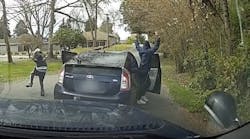Lane Change - Evasive Maneuver - Accident Avoidance - Swerve to Avoid... No matter what it's called they all have the same basic characteristics and are essential to all EVOC training programs. The feedback I receive from former students tells me that it (EVOC) teaches life saving skills, and if you have been teaching EVOC for any length of time my guess would be that you have experienced the same feedback. The evasive maneuver is simulating an unexpected event that can occur at anytime, anyplace and in a heartbeat.
The Maneuver
For purpose of this article I'll call it an Evasive Maneuver. I'm sure all EVOC instructors know what an Evasive Maneuver consists of, but to ensure we are all on the same page: an evasive maneuver consists of an entry gate, barrier, with lane gates on each side of the barrier and exit gate. There are many variations from that model, but again for the purpose of this article we will stay with the basics. The student enters the exercise by driving through a lane of cones, the entry gate, towards a barrier. Somewhere in the entry gate at a pre determined speed and location the student receives a signal from the instructor to go either left or right. The students executes the command (left or right) and drives through the given barrier lane. Once through the barrier lane the student drives into the exit gate.
A Review
Since the goal of the Evasive Maneuver is to create an emergency let's reexamine the basic definition of a vehicle emergency. A driving emergency is a time distance relationship - how much time and how much distance the student has. The student's ability to stay in control is a function of their skill in controlling the forces acting on the vehicle. Once the student receives the command the driver has to apply enough energy to move the vehicle away from the barrier and not too much energy that would cause the vehicle to go out of control, and - depending on the speed - do all that in a couple of tenths of a second; literally in the blink of an eye. Through exercise dimensions and implementation the instructor controls the amount of time and distance, and just as important, the amount of energy exerted on the vehicle. Basically the evasive exercise allows the instructor to create an emergency.
Exercises Dimensions
The level of difficulty of the evasive exercises and in turn a measure of the students proficiency is determine by the dimensions of the exercises and where the command signal is given to the student.
The critical design dimensions of the exercises are the distance from the entry gate to the barrier. The longer this dimension the more time and distance the student will have to execute the command. The next critical dimension is the length of the barrier. A good rule of thumb is to make the length of the barrier equal to the length of a vehicle. If you use a Crown Vic as an example the length of the barrier would be 18 Feet. The length of the barrier gate should be the width of a vehicle, again if you use the Crown Vic the barrier gate length would be 6.5 feet. The distance from the end of barrier gates to the exit gate, should be the same distance as the distance from the entry gate to the barrier.
Implementation
As important as the dimensions and maybe more important is, while in the entry gate, where and how the command to go left or right is given. How the command is given can be the subject of an article. In my years of doing this I have seen about every conceivable method of giving the command. For this article we will talk about where the command is given. In the design of the exercises there is a place in the entry gate where the signal is given. If the command is given a half second earlier or later, it’s like driving the student through a different exercise.
As an example the student drives into the entry gate at a speed of 40 MPH if the command is given 12 feet sooner that is the same as giving the student .2 seconds more time to react (40 MPH equals 58.8 feet a second or 5.9 feet every .1 second). Conversely, if the instructor gave the signal 12 feet later that would be similar to taking away .2 seconds of reaction time. There is a substantial difference between giving the signal 12 feet sooner or 12 feet later.
Another way of looking at the example, if the command is always given 75 feet from the barrier, and then it is given .2 seconds or 12 feet before the 75 foot mark the student now has 87 feet to execute the command. If it is given .2 seconds or 12 feet after the 75 foot mark they have 63 feet to execute the command. If everything is the same (the speed), the difference between having 87 feet to execute a decision and having 63 feet to execute a decision is rather exciting. As I tell the students, if you think it was exciting from inside the car you should see what it looks like from outside the car.
That is the bad news. Here is the good news: As an instructor you can use the above example as a teaching point. Purposely give the signal late and then early. Tell the student you are going to first take away .2 seconds of time and distance from the standard, then tell them you are going to give them .2 seconds from the standard.
The point it makes is one of the most important learning points a student can take away from an EVOC or for that matter any hands on driving program. The sooner you get the steering wheel moving away from what is in front of you the greater your chances of having a non-event.


